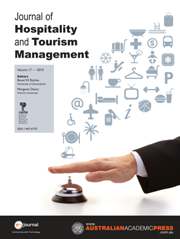Crossref Citations
This article has been cited by the following publications. This list is generated based on data provided by
Crossref.
Birna, Avital
Harvey Lemelin, Raynald
Powys Whyte, Kyle
Johansen, Kelsey
Higgins Desbiolles, Freya
Wilson, Christopher
and
Hemming, Steve
2013.
Conflicts, battlefields, indigenous peoples and tourism: addressing dissonant heritage in warfare tourism in Australia and North America in the twenty‐first century.
International Journal of Culture, Tourism and Hospitality Research,
Vol. 7,
Issue. 3,
p.
257.
Chambers, Donna
and
Buzinde, Christine
2015.
Tourism and decolonisation: Locating research and self.
Annals of Tourism Research,
Vol. 51,
Issue. ,
p.
1.
Weaver, David B.
2016.
Beyond convention: reimagining indigenous tourism.
Tourism Geographies,
Vol. 18,
Issue. 1,
p.
28.
Manrique, Carolina
Jamal, Tazim
and
Warden, Robert
2016.
Tourism Research Paradigms: Critical and Emergent Knowledges.
Vol. 22,
Issue. ,
p.
17.
Dann, Graham M. S.
2016.
Tourism Research Paradigms: Critical and Emergent Knowledges.
Vol. 22,
Issue. ,
p.
57.
Corral-Marfil, José-Antonio
and
Cànoves-Valiente, Gemma
2016.
Tourism Research Paradigms: Critical and Emergent Knowledges.
Vol. 22,
Issue. ,
p.
167.
Jamal, Tazim
and
Munar, Ana María
2016.
Tourism Research Paradigms: Critical and Emergent Knowledges.
Vol. 22,
Issue. ,
p.
191.
Munar, Ana María
2016.
Tourism Research Paradigms: Critical and Emergent Knowledges.
Vol. 22,
Issue. ,
p.
131.
Whitford, Michelle
and
Ruhanen, Lisa
2016.
Indigenous tourism research, past and present: where to from here?.
Journal of Sustainable Tourism,
Vol. 24,
Issue. 8-9,
p.
1080.
2016.
Tourism Research Paradigms: Critical and Emergent Knowledges.
Vol. 22,
Issue. ,
p.
203.
Camargo, Blanca A.
Jamal, Tazim
and
Wilson, Erica
2016.
Tourism Research Paradigms: Critical and Emergent Knowledges.
Vol. 22,
Issue. ,
p.
73.
Ek, Richard
and
Tesfahuney, Mekonnen
2016.
Tourism Research Paradigms: Critical and Emergent Knowledges.
Vol. 22,
Issue. ,
p.
113.
Munar, Ana María
and
Jamal, Tazim
2016.
Tourism Research Paradigms: Critical and Emergent Knowledges.
Vol. 22,
Issue. ,
p.
1.
Swain, Margaret Byrne
2016.
Tourism Research Paradigms: Critical and Emergent Knowledges.
Vol. 22,
Issue. ,
p.
87.
Takeuchi, Kazuyoshi
2016.
Tourism Research Paradigms: Critical and Emergent Knowledges.
Vol. 22,
Issue. ,
p.
155.
Shultis, John
and
Heffner, Susan
2016.
Hegemonic and emerging concepts of conservation: a critical examination of barriers to incorporating Indigenous perspectives in protected area conservation policies and practice.
Journal of Sustainable Tourism,
Vol. 24,
Issue. 8-9,
p.
1227.
Caton, Kellee
2016.
Tourism Research Paradigms: Critical and Emergent Knowledges.
Vol. 22,
Issue. ,
p.
35.
Swanson, Kristen K.
and
DeVereaux, Constance
2017.
A theoretical framework for sustaining culture: Culturally sustainable entrepreneurship.
Annals of Tourism Research,
Vol. 62,
Issue. ,
p.
78.
Lee, Emma
2017.
Performing colonisation: The manufacture of Black female bodies in tourism research.
Annals of Tourism Research,
Vol. 66,
Issue. ,
p.
95.
Pabel, Anja
Prideaux, Bruce
and
Thompson, Michelle
2017.
Tourists' preferences with Indigenous tourism experiences in the Wet Tropics of Queensland, Australia.
Journal of Hospitality and Tourism Management,
Vol. 31,
Issue. ,
p.
142.


